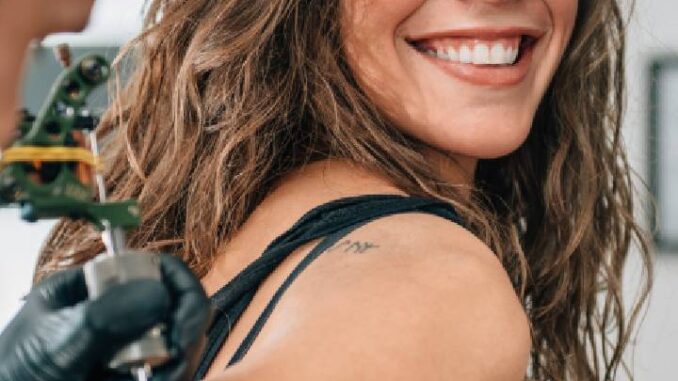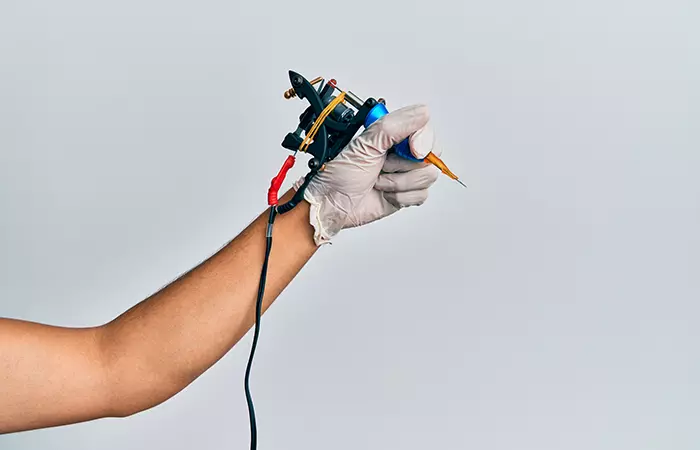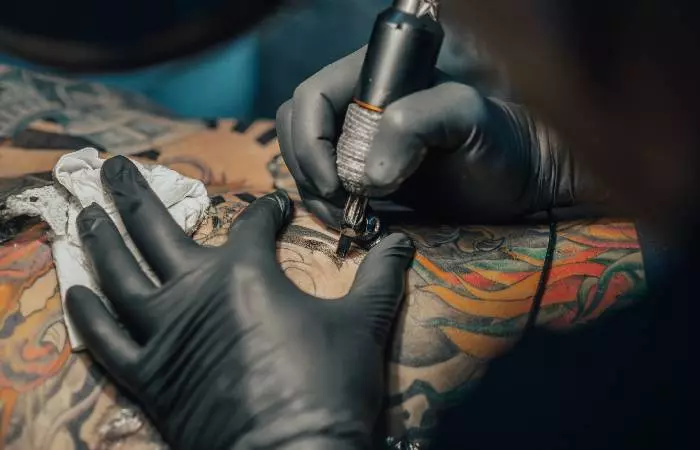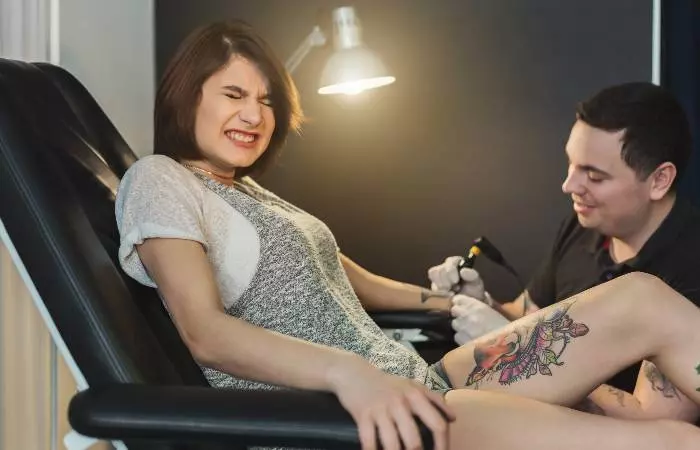
Getting a tattoo is really cool, but many find the tattooing process to be daunting. This makes absolute sense because it is something they are going to wear on their skin forever! But if you have got a low pain threshold and are wondering how deep does a tattoo needle go, then you might think twice before getting inked. Tattooing indeed is a painful process. The mere thought of tattoo needles puncturing your skin to create small holes to deposit ink can be nerve-wrecking for some, to say the least. However, how deep tattoo needles go depends on various factors such as the type of needle used, tattoo techniques, and the very location of the ink on the body. The tattooing process is a kind of mystery for many of us as if it were best kept secret. How do tattoo needles work? How deep does a tattoo needle go? How long does the tattoo ink stay in place? We are here to tell you everything you need to know before taking the plunge.
Types Of Tattoo Needles
 Image: Shutterstock
Image: Shutterstock
Let us begin by understanding the tattooing process first. A tattoo gun with disposable needles attached to it is used to draw strokes and fill the canvas of the skin with the pigment evenly. This electric device uses electromagnetic coils coupled with vacuum-seal technology to push ink into the skin. Tiny needles attached to the tattoo machine help distribute ink underneath the skin. These needles basically make space for the ink to settle into the skin.
Tattoo needles are made of chrome, steel, or even nickel and come in various sizes and configurations. There are many types of tattoo needles used for different tattooing styles like shading, dotting, coloring, and other varied tattoo processes. However, the most common tattoo needles with a standard thickness of 30mm–35 mm are used in the tattooing process. It is important to note that needles to achieve fine details can be even thinner than this. Further, round needles are used for lining or shading purposes, whereas flat needles are used to get clean lines.
Here are the different types of tattoo needles used in the inking process.
Round Tattoo Needles: These needles are soldered in a round pattern to give clear and precise lines. They are used for drawing traditional and non-traditional designs, geometric designs, and tribal and Japanese tattoo styles.
Round Liner Tattoo Needles: These needles are ideal for outlining, intricate detailing, and dot work. Round Shader Tattoo Needles: They have more space between the needles than round-liner tattoo needles. They are commonly used in line work, scripting, lettering, etc.
Flat Tattoo Needles:
These needles are soldered in straight lines. They are used to create clear, dark lines in one stroke. They are great for drawing mandala patterns or geometric tattoo designs..
Magnum Tattoo Needles: These needles are used for all sorts of shading work and color filling.
Curved Magnum Needles: These needles offer consistent ink disposal and have curved arcs, which makes them great for shading in areas with curves. Double Stack Magnum Needles: This consists of two rows of closely packed needles. They help with shading and filling large areas with pigment.
In addition, no matter the tattoo needle type, all needles are sterilized and disposed off after use to maintain cleanliness and hygiene and reduce the risk of infection at the tattooing site.

Do not consume alcohol at least 25 hours prior to getting inked. Anecdotal evidence suggests that it can heighten your pain sensitivity and make the process more difficult.
These were the basics of tattoo needles. To understand how deep a tattoo needle goes, check out the next section.
How Deep Does A Tattoo Needle Go?
 Image: Shutterstock
Image: Shutterstock
A tattoo needle goes around 1/16th of an inch deep into the skin. The electrical tattoo machine deposits ink around 1.5 mm–2mm beneath the outer layer of the skin. To understand this better, let us learn about some basics of skin anatomy. Our skin is basically divided into three distinct layers (1):
1. Epidermis: The outermost layer of the skin is composed of epidermal tissues.
2. Dermis: The dermis or second layer of the skin is made of body tissues, blood vessels, sweat glands, and hair follicles. This is the region where the tattoo ink is actually deposited.
3. Hypodermis: This contains a thick layer of fat and connective tissues.
Since we target the dermis layer during the tattooing process, the tattoo needle must pass through the epidermis layer of the skin to deposit the ink. As the outer layer of the skin is constantly renewing itself by shedding dead skin cells, getting a tattoo on the outermost layer of the skin can cause the ink to fade quickly or can leave you with a patchy tattoo.
However, the ink is deposited in the dermis layer where it won’t bleed out from the skin. A skilled tattoo artist knows how to inject ink in such a way that it reaches the right location. During this process, the level of pain will be comparatively low if the ink is to be injected into the hypodermis layer.
Meenakshi Reddy Madhavan, an author and a blogger, shared her tattooing experience: “I closed my eyes tightly and gripped the back of the chair and… felt the needle going in piercing fourteen layers of skin and coming out and it wasn’t so bad after all (i).” The blogger was of the opinion that the tattoo pain for her was relatively less than what she had imagined it to be.
Ensuring the correct tattoo needle depth can save you from unnecessary pain and discomfort and even lower the risk of infection. Having said that, it is best to look for a reputable tattoo salon and find a professional tattoo artist who knows how to handle the device correctly for you to get a less painful and more fun experience.
The pre-tattooing step involves the tattoo artist adjusting the tattoo machine such that the needle will hit right at the intended dermis layer location, which is just the sweet spot between the epidermis and hypodermis layer.
Another thing to keep in mind is that the depth at which the needle penetrates the skin depends on skin thickness and the very location of the tattoo on the body. For instance, areas such as the wrist, ankle, fingers, toes, etc have thinner skin compared to the rest of the body. Apart from that, the tattoo needle depth and angle depend on the technique deployed by the tattoo artist. Some artists might use shallow art of tattooing in which the needle penetrates only a few millimeters into the skin.
In addition to that, the different size tattoo needles are specifically designed to enter 1 mm-2 mm below the surface of the skin. A good tattoo artist will ensure correct tattoo needle depth and pressure for you to get a long-lasting, painless experience.

Tattoo needles puncture the upper layer of the skin, but if it is too shallow it can cause the tattoo to fade quickly. On the other hand, if it goes too deep, it can increase the risk of scarring. In some cases, the tattoo needle may hit the vein. Let us find out what happens in that case below.
What Happens If A Tattoo Needle Hits A Vein?
 Image: Shutterstock
Image: Shutterstock
At times, the tattoo needle can pass through both the epidermis and dermis layers of the skin, reaching the hypodermis. This can lead to a large amount of blood oozing from the skin, irritation, and discomfort. This can also cause the client to experience more pain than usual. This brings us to what happens if a tattoo needle hits a vein instead. Well, if the needle hits the vein it can puncture or rupture the vein which can cause the tattoo ink to enter the veins and thereby the bloodstream. Further, it can increase the risk of infection and even lead to scarring (3). Not just that, it can leave one with a tattoo blowout, where the skin around the tattoo appears shadowy owing to the spread of ink within the skin due to the deep penetration of needles.
It is important to note that an experienced tattoo artist should know the right depth and technique during the inking procedure for the tattoo design for one to get a safe tattooing experience. This brings us to the question where the ink finally settles once the tattoo is healed completely. Let us find out in the next section.
Where Does The Ink Settle Once Healed?
 Image: Shutterstock
Image: Shutterstock
The epidermis layer is constantly renewing itself, which can lead to loss of ink from the upper layer of the skin and leave you with a faded tattoo. During the tattoo healing process, the skin is prone to flaking and eventually, the scabs fall off. The ink that is trapped underneath in the upper layer of the dermis is what remains. The very depth enables the tattoo to stay permanent, even if there is new hair growth on the piece of art. Hence, the exact measure of the depth that a tattoo needle goes to is very important.
The depth of tattoo needles into the skin is important in the tattooing process to create better-quality tattoos that last incredibly long. And for this make sure to go to an experienced tattoo artist to decide the tattoo style and design, the specific area of the body to be tattooed, and one that can efficiently control depth to reduce the chance of scarring or infection. Remember, for a tattoo to be permanent, the ink must reach the dermis as it is a protective layer of the skin that is less affected by external factors such as sweat, sunlight, and other environmental aggressors.
Frequently Asked Questions
How often do you dip a tattoo needle in ink?
To maintain a steady flow of ink and ensure a smooth tattooing process, one should dip the tattoo needle in ink every 5 seconds or so. However, it also depends on various factors such as ink viscosity, needle type, color, speed of the tattoo artist, and client’s skin type.
How to set needle depth on a rotary tattoo machine?
The needle depth on the rotatory machine is achieved by changing and adjusting the electric machine’s stroke length. It’s the stroke length that determines how far the needle set will penetrate.
How many needles are in a tattoo gun?
The number of needles in a tattoo gun is directly proportional to the size and the type of the needle. It can be a single needle or a set of needles. Most commonly, tattoo guns with needle sizes of 8mm, 10mm, and 12 mm are used for the tattooing process.
Key Takeaways
Tattoo electrical devices use disposable needles made of materials such as chrome, steel, or nickel. These needles come in varied sizes, thicknesses, and configurations suitable for different tattooing styles. The tattoo needle roughly penetrates around 1/16 inch deep into the skin, while depositing the ink around 1.5mm–2mm below the upper layer of the skin. The dermis is the layer where the tattoo ink is ideally deposited in the skin. The precise tattoo needle depth can help lower pain and minimize discomfort and risk of infection. It can also ensure a smooth tattooing process and the body artworks last longer.
Image: Dall·E/StyleCraze Design Team
The following YouTube video discusses if the depth of the tattoo directly affects the quality of the tattoo. Check it out to discover ways to get a better quality tattoo and tips to reduce pain during the tattooing process.
Personal Experience: Source
Was this article helpful? ReviewerAuthorEditorFact Checker
![]() Dr. Seepika Jaiswal is a cosmetic dermatologist, hair transplant surgeon, and micro pigmentation specialist with 7 years of experience. After completing her MBBS, she went on to do a diploma in weight loss and another in clinical dermatology from the University of London.
Dr. Seepika Jaiswal is a cosmetic dermatologist, hair transplant surgeon, and micro pigmentation specialist with 7 years of experience. After completing her MBBS, she went on to do a diploma in weight loss and another in clinical dermatology from the University of London.
Read full bio of Dr. Seepika Jaiswal
![]() Joyce Joyson is a beauty and lifestyle writer with over a year of experience crafting short-form content for the beauty, fashion, and lifestyle niches. She has a triple majors bachelor’s degree in History, Political Science, and Geography from IIS University and a master’s degree in Mass Communication and Journalism from Kristu Jayanti College.
Joyce Joyson is a beauty and lifestyle writer with over a year of experience crafting short-form content for the beauty, fashion, and lifestyle niches. She has a triple majors bachelor’s degree in History, Political Science, and Geography from IIS University and a master’s degree in Mass Communication and Journalism from Kristu Jayanti College.
Read full bio of Joyce Joyson
![]() Subhrojyoti is an associate editor at StyleCraze with four years of experience. He has a master’s degree in English from Presidency University, Kolkata, and has also done a post-graduate certificate course in Editing and Publishing from Jadavpur University, Kolkata.
Subhrojyoti is an associate editor at StyleCraze with four years of experience. He has a master’s degree in English from Presidency University, Kolkata, and has also done a post-graduate certificate course in Editing and Publishing from Jadavpur University, Kolkata.
Read full bio of Subhrojyoti Mukherjee
![]() Aparna Harry is a beauty and lifestyle content writer with over three years of experience in writing for different genres. She has a master’s degree in English Literature from The English And Foreign Languages University and a bachelor’s degree in education from the University of Mysore.
Aparna Harry is a beauty and lifestyle content writer with over three years of experience in writing for different genres. She has a master’s degree in English Literature from The English And Foreign Languages University and a bachelor’s degree in education from the University of Mysore.
Read full bio of Aparna Harry
Leave a Reply